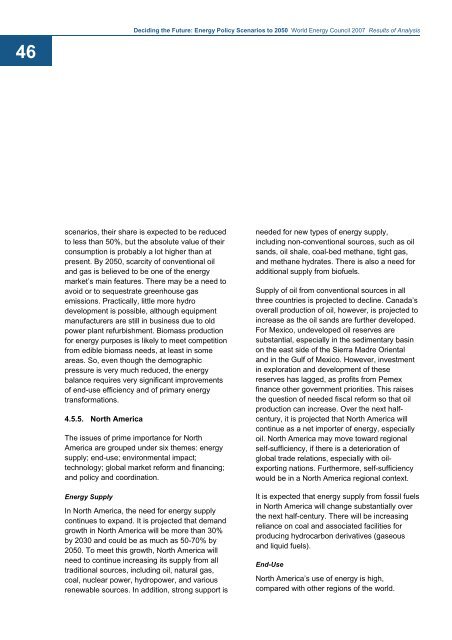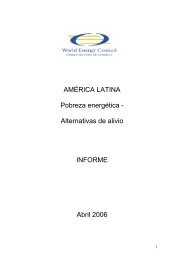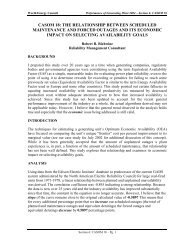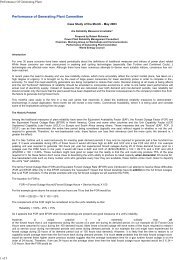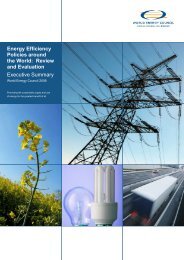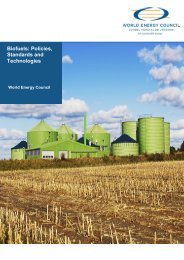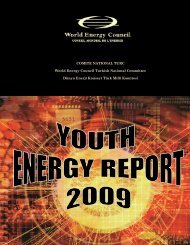Deciding the Future: Energy Policy Scenarios to 2050
Deciding the Future: Energy Policy Scenarios to 2050
Deciding the Future: Energy Policy Scenarios to 2050
Create successful ePaper yourself
Turn your PDF publications into a flip-book with our unique Google optimized e-Paper software.
46<br />
<strong>Deciding</strong> <strong>the</strong> <strong>Future</strong>: <strong>Energy</strong> <strong>Policy</strong> <strong>Scenarios</strong> <strong>to</strong> <strong>2050</strong> World <strong>Energy</strong> Council 2007 Results of Analysis<br />
scenarios, <strong>the</strong>ir share is expected <strong>to</strong> be reduced<br />
<strong>to</strong> less than 50%, but <strong>the</strong> absolute value of <strong>the</strong>ir<br />
consumption is probably a lot higher than at<br />
present. By <strong>2050</strong>, scarcity of conventional oil<br />
and gas is believed <strong>to</strong> be one of <strong>the</strong> energy<br />
market’s main features. There may be a need <strong>to</strong><br />
avoid or <strong>to</strong> sequestrate greenhouse gas<br />
emissions. Practically, little more hydro<br />
development is possible, although equipment<br />
manufacturers are still in business due <strong>to</strong> old<br />
power plant refurbishment. Biomass production<br />
for energy purposes is likely <strong>to</strong> meet competition<br />
from edible biomass needs, at least in some<br />
areas. So, even though <strong>the</strong> demographic<br />
pressure is very much reduced, <strong>the</strong> energy<br />
balance requires very significant improvements<br />
of end-use efficiency and of primary energy<br />
transformations.<br />
4.5.5. North America<br />
The issues of prime importance for North<br />
America are grouped under six <strong>the</strong>mes: energy<br />
supply; end-use; environmental impact;<br />
technology; global market reform and financing;<br />
and policy and coordination.<br />
<strong>Energy</strong> Supply<br />
In North America, <strong>the</strong> need for energy supply<br />
continues <strong>to</strong> expand. It is projected that demand<br />
growth in North America will be more than 30%<br />
by 2030 and could be as much as 50-70% by<br />
<strong>2050</strong>. To meet this growth, North America will<br />
need <strong>to</strong> continue increasing its supply from all<br />
traditional sources, including oil, natural gas,<br />
coal, nuclear power, hydropower, and various<br />
renewable sources. In addition, strong support is<br />
needed for new types of energy supply,<br />
including non-conventional sources, such as oil<br />
sands, oil shale, coal-bed methane, tight gas,<br />
and methane hydrates. There is also a need for<br />
additional supply from biofuels.<br />
Supply of oil from conventional sources in all<br />
three countries is projected <strong>to</strong> decline. Canada’s<br />
overall production of oil, however, is projected <strong>to</strong><br />
increase as <strong>the</strong> oil sands are fur<strong>the</strong>r developed.<br />
For Mexico, undeveloped oil reserves are<br />
substantial, especially in <strong>the</strong> sedimentary basin<br />
on <strong>the</strong> east side of <strong>the</strong> Sierra Madre Oriental<br />
and in <strong>the</strong> Gulf of Mexico. However, investment<br />
in exploration and development of <strong>the</strong>se<br />
reserves has lagged, as profits from Pemex<br />
finance o<strong>the</strong>r government priorities. This raises<br />
<strong>the</strong> question of needed fiscal reform so that oil<br />
production can increase. Over <strong>the</strong> next halfcentury,<br />
it is projected that North America will<br />
continue as a net importer of energy, especially<br />
oil. North America may move <strong>to</strong>ward regional<br />
self-sufficiency, if <strong>the</strong>re is a deterioration of<br />
global trade relations, especially with oilexporting<br />
nations. Fur<strong>the</strong>rmore, self-sufficiency<br />
would be in a North America regional context.<br />
It is expected that energy supply from fossil fuels<br />
in North America will change substantially over<br />
<strong>the</strong> next half-century. There will be increasing<br />
reliance on coal and associated facilities for<br />
producing hydrocarbon derivatives (gaseous<br />
and liquid fuels).<br />
End-Use<br />
North America’s use of energy is high,<br />
compared with o<strong>the</strong>r regions of <strong>the</strong> world.


